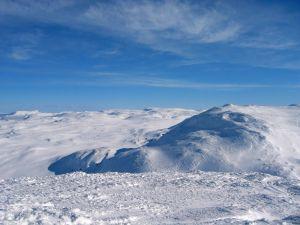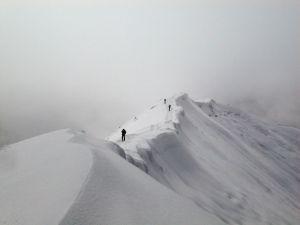It covers a large part of our planet, causes many deaths each year and inconveniences millions. It's time to learn some interesting facts about snow and ice.
 Before winter leaves the northern hemisphere I'll take this opportunity to tell you a bit about the white stuff that has been lying two feet thick in my yard for the past few months.
Before winter leaves the northern hemisphere I'll take this opportunity to tell you a bit about the white stuff that has been lying two feet thick in my yard for the past few months.
First of all, by now most of it is ice, either individual crystals or packed solid, though it still looks like snow. What's on top, having been exposed to the warm sun all day today, is what is known to skiers as corn snow. That's really lumps of white ice, crystals the size of small kernels of corn.
Ice itself is unusual because it's not like any other solid. Water expands when it freezes, unlike (almost) every other material that shrinks when it becomes a solid. Ice continues to melt and refreeze down to extremely cold temperatures, which explains many peculiar characteristics that northerners experience, such as it forming around a shovel left in it for a few days.
Snow is technically a mineral, like iron and salt.
The Innu people of northern Canada, Siberia and Greenland do not have dozens of names for snow, as you may have learned in school. In their languages (Innuit and Inuktitut among them) they combine several descriptive words into a single word. For example, "snow that drifts into a wave-like pattern" (eight words in English) would exist as one word in Innuit. So their "many words for snow" are really combinations of words to describe particular snow conditions (on the ground, not falling).
The Algonquian Indians of northern Canada (neighbours of the Innu, but below the tree line) long ago hated them so much that they killed them on sight, especially after the white men supplied them with rifles. Without trees for fuel, the Innu tended to eat the flesh of animals they killed raw, often their only warm food. Because of this the Algonquians called them "Eaters of Raw Flesh," or Eskimoes in the Algonquian language.
The Innu call themselves Innuit, meaning "the people." The word is spelled Inuit and Innuit in English, in different places, depending on who does the translation.
Another myth you may have been taught is that each snowflake is individual and unique. Most snowflakes tend to stick together with others into globular crystals. And lots of snow flakes look similar to anyone who takes the trouble to look closely at enough of them. For each one to have a unique shape and composition would be a statistical impossibility.
Most snow crystals - the prettier ones - are very wide but very thin. Though they're thinner than a piece of paper, they may be up to a few inches wide. The Guinness Book of Records lists the largest snowflake at 15 inches across, a record held in Keogh, Montana, USA, since 1887.
At the centre of each snowflake is a speck of dust, volcanic ash or particle from outer space. Temperature, humidity and wind determine the shape each crystal takes as water vapour freezes on it.
 Newly fallen snow is usually about 90 - 95 percent air, which explains its property as a good thermal insulator.
Newly fallen snow is usually about 90 - 95 percent air, which explains its property as a good thermal insulator.
A blizzard with lightning is called thundersnow. They're rare, but one this winter in our area brought down enough trees that power was out over a wide area for several hours as workers tried to find then repair the many damaged lines and transformers.
You likely have heard that you shouldn't eat yellow snow. It's...well, pee. But don't eat the red snow either. Often called "watermelon snow," it even smells like the fruit. But it's colour comes from a species of pigmented algae that grows in ice. Red snow may taste great, but stay close to a toilet for a day or so.
Although avalanche deaths have risen dramatically over the past half century due to the increasing popularity of skiing and snowmobiling--250 deaths in the US over the past decade--it's not undefined that shouting, yodeling or other loud sounds will trigger an avalanche.
The most snow in the USA usually falls on Valdez, Alaska. It receives an average of 326 inches of it per year. Never mind that it's 27 feet of snow, that would turn into 2.7 feet deep of water over everything in the area if it all melted at once. Because of the air within it, snow takes up ten times as much space as liquid water.
Despite how white the North and South Poles are, it snows very little there. The little bit it does snow each year never melts, but it accumulates over decades and blows around a lot, creating blizzard or white-out conditions.
The snow in Antarctica is mostly so hard and flat that it reflects sound as well as light. Researchers have heard human voices talking as much as one mile (1.6 km) away.
A man named "Snowflake" Bentley admired the flakes so much that in 1885 he took closeup pictures of some 5,000 individual flakes. He died of pneumonia. No kidding.
In addition to snow blindness you can get from overexposure of the brightness of snow on the retinas of the eyes, it can also drive people crazy. A little understood kind of hysteria called pibloktoq can cause a variety of symptoms including echolalia (senselessly repeating words overheard from another person) and running around naked in the snow. Note that this is not the same as the Scandinavian ritual following the sauna, despite appearances.
According to one theory of earth history called "snowball earth," our entire planet was covered with snow and ice some 600 million years ago. Opponents argue that no complex life form could have survived in that environment. However, it's impossible to know if the oceans were frozen over and how much life could have survived near the water if only the land were covered with snow and ice.
Now I really must chuck some firewood into our wood stove before hypothermia sets in.
Bill Allin
Turning It Around: Causes and Cures for Today's Epidemic Social Problems, a book about how, what and when to teach children what they need to learn to be competent and confident adults. That's stuff they rarely learn in school and often not at home.
Learn more at http://billallin.com
